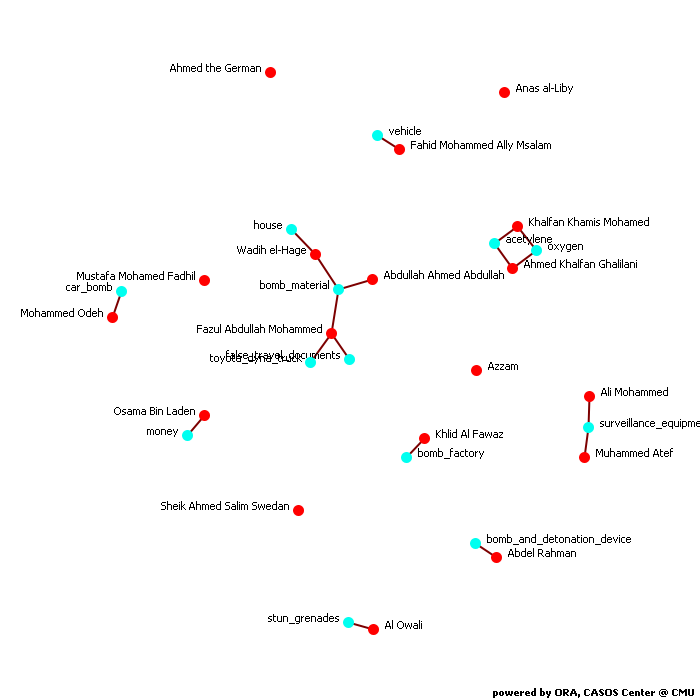
Network Level Measures
Measure Value Row count 18.000 Column count 13.000 Link count 18.000 Density 0.077
Node Level Measures
Measure Min Max Avg Stddev In-degree centrality 0.056 0.167 0.077 0.035 In-degree centrality [Unscaled] 1.000 3.000 1.385 0.625 Out-degree centrality 0.000 0.231 0.077 0.063 Out-degree centrality [Unscaled] 0.000 3.000 1.000 0.816
Key Nodes
In-degree centrality
The In Degree Centrality of a node is its normalized in-degree. For any node, e.g. an individual or a resource, the in-links are the connections that the node of interest receives from other nodes. For example, imagine an agent by knowledge matrix then the number of in-links a piece of knowledge has is the number of agents that are connected to. The scientific name of this measure is in-degree and it is calculated on the agent by agent matrices.
Input network(s): agent x resource
Rank Resource Value Unscaled 1 bomb_material 0.167 3.000 2 surveillance_equipment 0.111 2.000 3 oxygen 0.111 2.000 4 acetylene 0.111 2.000 5 false_travel_documents 0.056 1.000 6 bomb_and_detonation_device 0.056 1.000 7 stun_grenades 0.056 1.000 8 toyota_dyna_truck 0.056 1.000 9 money 0.056 1.000 10 vehicle 0.056 1.000 Out-degree centrality
For any node, e.g. an individual or a resource, the out-links are the connections that the node of interest sends to other nodes. For example, imagine an agent by knowledge matrix then the number of out-links an agent would have is the number of pieces of knowledge it is connected to. The scientific name of this measure is out-degree and it is calculated on the agent by agent matrices. Individuals or organizations who are high in most knowledge have more expertise or are associated with more types of knowledge than are others. If no sub-network connecting agents to knowledge exists, then this measure will not be calculated. The scientific name of this measure is out degree centrality and it is calculated on agent by knowledge matrices. Individuals or organizations who are high in "most resources" have more resources or are associated with more types of resources than are others. If no sub-network connecting agents to resources exists, then this measure will not be calculated. The scientific name of this measure is out degree centrality and it is calculated on agent by resource matrices.
Input network(s): agent x resource
Rank Agent Value Unscaled 1 Fazul Abdullah Mohammed 0.231 3.000 2 Khalfan Khamis Mohamed 0.154 2.000 3 Ahmed Khalfan Ghalilani 0.154 2.000 4 Wadih el-Hage 0.154 2.000 5 Muhammed Atef 0.077 1.000 6 Abdullah Ahmed Abdullah 0.077 1.000 7 Fahid Mohammed Ally Msalam 0.077 1.000 8 Osama Bin Laden 0.077 1.000 9 Al Owali 0.077 1.000 10 Ali Mohammed 0.077 1.000
Key Nodes Table
This shows the top scoring nodes side-by-side for selected measures.
Rank Betweenness centrality Closeness centrality Eigenvector centrality Eigenvector centrality per component In-degree centrality In-Closeness centrality Out-degree centrality Total degree centrality 1 - - - - bomb_material - Fazul Abdullah Mohammed - 2 - - - - surveillance_equipment - Khalfan Khamis Mohamed - 3 - - - - oxygen - Ahmed Khalfan Ghalilani - 4 - - - - acetylene - Wadih el-Hage - 5 - - - - false_travel_documents - Muhammed Atef - 6 - - - - bomb_and_detonation_device - Abdullah Ahmed Abdullah - 7 - - - - stun_grenades - Fahid Mohammed Ally Msalam - 8 - - - - toyota_dyna_truck - Osama Bin Laden - 9 - - - - money - Al Owali - 10 - - - - vehicle - Ali Mohammed -